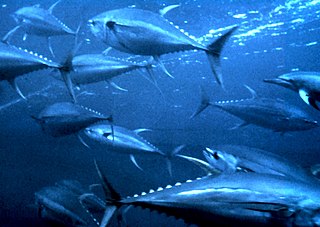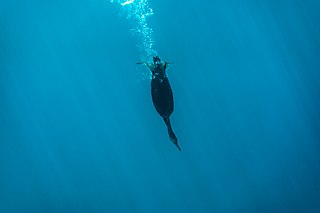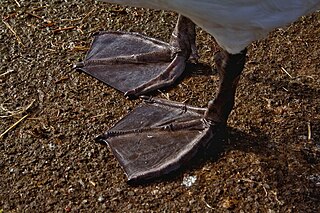Related Research Articles

A fin is a thin component or appendage attached to a larger body or structure. Fins typically function as foils that produce lift or thrust, or provide the ability to steer or stabilize motion while traveling in water, air, or other fluids. Fins are also used to increase surface areas for heat transfer purposes, or simply as ornamentation.

Quadrupedalism is a form of locomotion where four limbs are used to bear weight and move around. An animal or machine that usually maintains a four-legged posture and moves using all four limbs is said to be a quadruped. Quadruped animals are found among both vertebrates and invertebrates.

Biomechanics is the study of the structure, function and motion of the mechanical aspects of biological systems, at any level from whole organisms to organs, cells and cell organelles, using the methods of mechanics. Biomechanics is a branch of biophysics.

A flipper is a broad, flattened limb adapted for aquatic locomotion. It refers to the fully webbed, swimming appendages of aquatic vertebrates that are not fish.

Fish locomotion is the various types of animal locomotion used by fish, principally by swimming. This is achieved in different groups of fish by a variety of mechanisms of propulsion, most often by wave-like lateral flexions of the fish's body and tail in water, and in various specialised fish by motions of the fins. The major forms of locomotion in fish are:

Allometry is the study of the relationship of body size to shape, anatomy, physiology and finally behaviour, first outlined by Otto Snell in 1892, by D'Arcy Thompson in 1917 in On Growth and Form and by Julian Huxley in 1932.
Gravitational biology is the study of the effects gravity has on living organisms. Throughout the history of the Earth life has evolved to survive changing conditions, such as changes in the climate and habitat. However, one constant factor in evolution since life first began on Earth is the force of gravity. As a consequence, all biological processes are accustomed to the ever-present force of gravity and even small variations in this force can have significant impact on the health and function and the system of organisms.

Several organisms are capable of rolling locomotion. However, true wheels and propellers—despite their utility in human vehicles—do not seem to play a significant role in the movement of living things. Biologists have offered several explanations for the apparent absence of biological wheels, and wheeled creatures have appeared often in speculative fiction.

Aquatic locomotion or swimming is biologically propelled motion through a liquid medium. The simplest propulsive systems are composed of cilia and flagella. Swimming has evolved a number of times in a range of organisms including arthropods, fish, molluscs, amphibians, reptiles, birds, and mammals.

Gray's Paradox is a paradox posed in 1936 by British zoologist Sir James Gray. The paradox was to figure out how dolphins can obtain such high speeds and accelerations with what appears to be a small muscle mass. Gray made an estimate of the power a dolphin could exert based on its physiology, and concluded the power was insufficient to overcome the drag forces in water. He hypothesized that Dolphin's skin must have special anti-drag properties.

Certain species of fish and birds are able to locomote in both air and water, two fluid media with very different properties. A fluid is a particular phase of matter that deforms under shear stresses and includes any type of liquid or gas. Because fluids are easily deformable and move in response to applied forces, efficiently locomoting in a fluid medium presents unique challenges. Specific morphological characteristics are therefore required in animal species that primarily depend on fluidic locomotion. Because the properties of air and water are so different, swimming and flying have very disparate morphological requirements. As a result, despite the large diversity of animals that are capable of flight or swimming, only a limited number of these species have mastered the ability to both fly and swim. These species demonstrate distinct morphological and behavioral tradeoffs associated with transitioning from air to water and water to air.

Aquatic feeding mechanisms face a special difficulty as compared to feeding on land, because the density of water is about the same as that of the prey, so the prey tends to be pushed away when the mouth is closed. This problem was first identified by Robert McNeill Alexander. As a result, underwater predators, especially bony fish, have evolved a number of specialized feeding mechanisms, such as filter feeding, ram feeding, suction feeding, protrusion, and pivot feeding.

Hydrodynamic reception refers to the ability of some animals to sense water movements generated by biotic or abiotic sources. This form of mechanoreception is useful for orientation, hunting, predator avoidance, and schooling. Frequent encounters with conditions of low visibility can prevent vision from being a reliable information source for navigation and sensing objects or organisms in the environment. Sensing water movements is one resolution to this problem.

John Oluseun Dabiri is a Nigerian-American aeronautics engineer and the Centennial Chair Professor at the California Institute of Technology (Caltech), with appointments in the Graduate Aerospace Laboratories (GALCIT) and Mechanical Engineering. His research focuses on unsteady fluid mechanics and flow physics, with particular emphasis on topics relevant to biology, energy, and the environment. He is best known for his research of the hydrodynamics of jellyfish propulsion and the design of a vertical-axis wind farm adapted from schooling fish. He is the director of the Biological Propulsion Laboratory, which examines fluid transport with applications in aquatic locomotion, fluid dynamic energy conversion, and cardiac flows, as well as applying theoretical methods in fluid dynamics and concepts of optimal vortex formation.

Fins are distinctive anatomical features composed of bony spines or rays protruding from the body of a fish. They are covered with skin and joined together either in a webbed fashion, as seen in most bony fish, or similar to a flipper, as seen in sharks. Apart from the tail or caudal fin, fish fins have no direct connection with the spine and are supported only by muscles. Their principal function is to help the fish swim.

Daniel E. Lieberman is a paleoanthropologist at Harvard University, where he is the Edwin M Lerner II Professor of Biological Sciences, and Professor in the Department of Human Evolutionary Biology. He is best known for his research on the evolution of the human head and the human body.

The webbed foot is a specialized limb with interdigital membranes (webbings) that aids in aquatic locomotion, present in a variety of tetrapod vertebrates. This adaptation is primarily found in semiaquatic species, and has convergently evolved many times across vertebrate taxa.
Batoids are a superorder of cartilaginous fish consisting of skates, rays and other fish all characterized by dorsoventrally flattened bodies and large pectoral fins fused to the head. This distinctive morphology has resulted in several unique forms of locomotion. Most Batoids exhibit median paired fin swimming, utilizing their enlarged pectoral fins. Batoids that exhibit median paired fin swimming fall somewhere along a spectrum of swimming modes from mobuliform to rajiform based on the number of waves present on their fin at once. Of the four orders of Batoidae this holds truest for the Myliobatiformes (rays) and the Rajiformes (skates). The two other orders: Rhinopristiformes and Torpediniformes exhibit a greater degree of body caudal fin swimming.

Brooke E. Flammang is an American biologist at the New Jersey Institute of Technology. She specializes in functional morphology, biomechanics, and bioinspired technology of fishes. Flammang is a discoverer of the radialis muscle in shark tails. She also studies the adhesive disc of the remora, and the walking cavefish, Cryptotora thamicola. Her work has been profiled by major news outlets including The New York Times, The Washington Post, Wired, BBC Radio 5, Discovery Channel, and National Geographic Wild. She was named one of the "best shark scientists to follow" by Scientific American in 2014.
Pavlos P. Vlachos is a Greek-American engineer, scientist, academic, and entrepreneur. He is professor in Purdue’s School of Mechanical Engineering and in the Weldon School of Biomedical Engineering, and the St. Vincent Health Professor of Healthcare Engineering. He serves as the Director for the Purdue Regenstrief Center for Healthcare Engineering (RCHE).
References
- ↑ http://www.people.fas.harvard.edu/~glauder/lauder.htm Lauder's CV at Harvard
- ↑ "Center for Ocean Engineering".
- ↑ "Archived copy" (PDF). Archived from the original (PDF) on 2009-05-26. Retrieved 2009-10-31.
{{cite web}}: CS1 maint: archived copy as title (link) - ↑ Drucker, Eliot G. & George V. Lauder Experimental Hydrodynamics of Fish Locomotion: Functional Insights from Wake Visualization 1, Integ. and Comp. Biol., 42:243–257